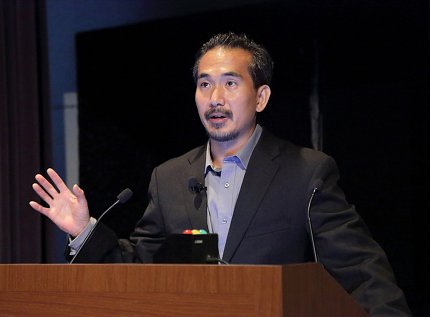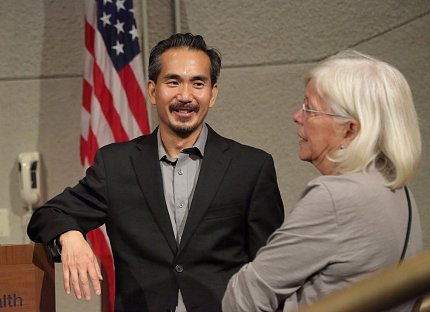Chou Urges Non-Opioid Therapies for Chronic Pain

Photo: Ernie Branson
Pain is a major public health concern in the United States. More than 25 million of us experience it every day, according to the National Health Interview Survey. But treating it with opioids, a class of pain-relieving drugs, invites problems including misuse, addiction and overdose. Common opioids include hydrocodone, oxycodone, fentanyl and morphine. How can health care providers and their patients with chronic pain, which differs from acute pain, evaluate these drugs and other potential treatments so that care can be as effective and safe as possible?
Dr. Roger Chou, an expert on clinical guidelines and systematic reviews on health topics, provided insights in a recent lecture at NIH. He focused on clinical practice guidelines for primary care providers on opioid treatment of adults with chronic pain. The guidelines coauthored by him were released by the Centers for Disease Control and Prevention last March. Chou is professor of medicine at Oregon Health & Science University, director of the Pacific Northwest Evidence-based Practice Center and a board-certified internist. His talk was part of the Integrative Medicine Research Lecture Series sponsored by NCCIH, whose research portfolio has a major emphasis on pain management.
Chou took listeners down what might be described as a 4-lane highway, with one lane being opioids, the second non-opioid drugs and the third nondrug therapies ranging from cognitive behavioral therapy (CBT) and exercise to acupuncture and spinal manipulation. The fourth lane was his team’s findings supporting a multimodal approach to chronic pain that does not rely exclusively on opioids. Much of the “scenery” included harms being done to individuals and society from the nation’s opioid epidemic.
According to statistics from the CDC, from 2000 to 2010 the rates of opioid prescriptions, opioid-related deaths and admissions for opioid use disorder all quadrupled. In addition, since 2008, opioid-related deaths have displaced motor vehicle accidents as the leading cause of accidental death in most states. A SAMHSA survey found that, in 2010, about one in 12 children in junior high or high school used a pain medication not prescribed for them. In a nutshell, Chou said, “We in the U.S. prescribe more opioids than any other nation, our chronic pain status is not better than [anyone else’s] and we have a lot more opioid-related deaths and addiction.”
In earlier research presented in 2014 at NIH’s workshop Pathways to Prevention: The Role of Opioids in Treatment of Chronic Pain and in developing the guidelines, Chou and his colleagues did not find strong support that opioids work for chronic pain. They did, however, find support for treatment options that work about as well (alone or in combination) as opioids and are safer. This is captured in the CDC guidelines’ first of 12 recommendations:
“Non-pharmacologic therapy and non-opioid pharmacologic therapy are preferred for chronic pain. Clinicians should consider opioid therapy only if expected benefits for both pain and function are anticipated to outweigh risks to the patient. If opioids are used, they should be combined with non-pharmacologic therapy and non-opioid pharmacologic therapy, as appropriate.”
“This is one of our most important recommendations,” said Chou, “to try to use the non-opioid therapies as much as possible. We know that a lot of them are similar, or only slightly [less effective] compared with opioids, and have fewer serious side effects. Nobody overdoses, for example, from too much CBT or too much massage.” Among other options, he said, are acupuncture, tai chi, mindfulness meditation and relaxation techniques, as well as drugs that are not opioids but treat pain (e.g., acetaminophen, NSAIDs and certain antidepressants and anticonvulsants).

Photo: Ernie Branson
Such therapies can also support clinicians’ efforts to decrease dosages of opioids in pain patients who have been taking them long-term and thus inevitably develop tolerance. “I tell my patients on high doses that it is like they are going 150 mph [with opioids]; even if they haven’t had an accident yet, they are at risk for one,” said Chou. “If, by working together, we can get down to 130 mph or lower, that’s progress.” Since it can be difficult for patients to access many of these nondrug therapies, Chou added, policy and implementation research are needed to move toward the optimal approach described in the CDC guidelines.
Many complementary therapies have been evaluated in pain studies, Chou said, recapping the evidence. When making decisions, he urged, “Consider which ones have the greatest benefit relative to risks. Benefits may vary based on patients’ expectations. We also think it makes sense to prioritize therapies that are more active [for the patient] than passive and that focus on movement and function. Just giving someone a pain medication is not going to address the psychosocial factors that we know are so important in contributing to pain, or the psychological comorbidities extremely important in people with pain.”
Chou concluded, “The available evidence suggests that the potential benefits of opioids are, at best, finely balanced with the harms. I think this supports the approach in the CDC guidelines, including use of non-opioid treatment for chronic pain rather than always throwing opioids at these patients.”
The full lecture is available at https://videocast.nih.gov/Summary.asp?Live=20079&bhcp=1.
